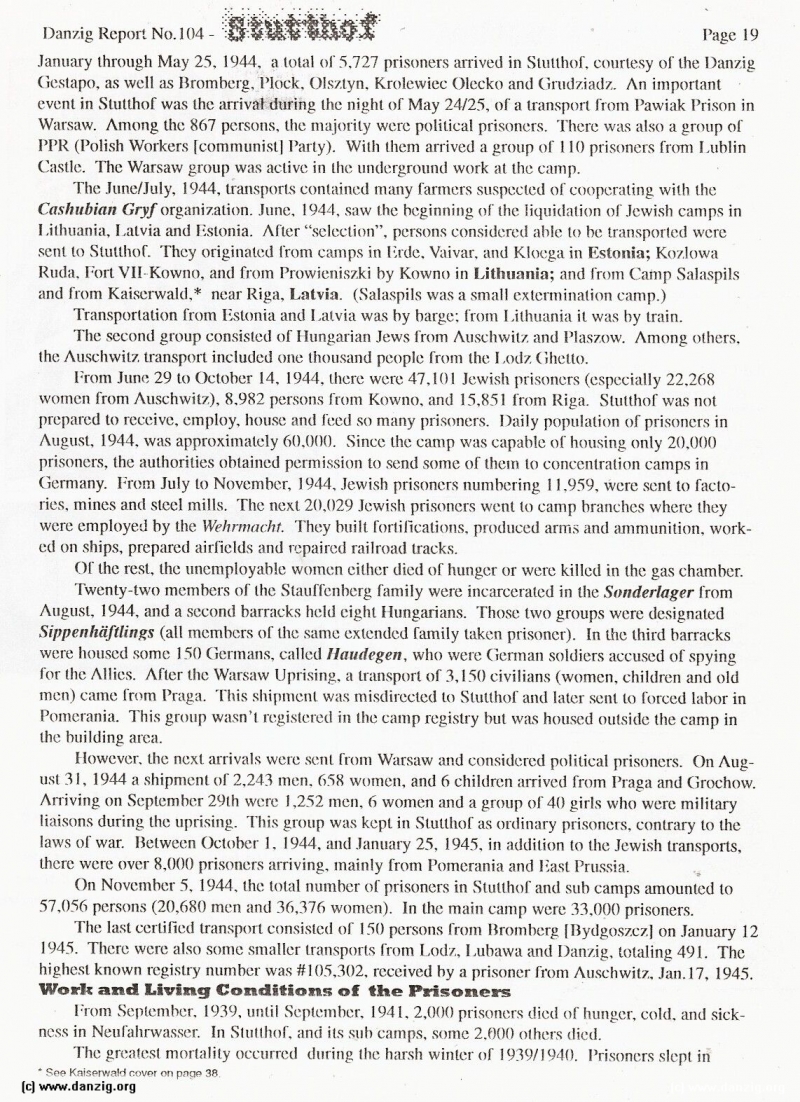
January through May 25, 1944. a lotal of 5.727 prisoners arrived in Slutihof. courtesy of the Danzig Gestapo. as well as llromhcrg. Mock. Olsztyn. Krolcwiec Olecko and (irudziadz. An important event in Stutthof was the arrival during the night of May 24/25. of a transport from Pawiak Prison in Warsaw. Among the 867 persons. the majority Were political prisoners. Ihere was also a group of PPR (Polish Workers Icommunisti Party). With them arrived a group of 110 prisoners from I uh1in Castle. The Warsaw group was active in the iiiiderground work at the camp.
The June/July, 1944. transports continnc(l many farmers suspected of cooperating with the (asIiiibian Giyf organization. .June, 1944. saw the beginning of the liquidation of Jewish camps in I .ithuania, I atvia and I stonia. After “selection”, persons considered able to he transported were sent to Stutthof. They originated From camps in I rde. Vaivar. and Klocga in Fstonia; Kozlowa Ruda, I ort VII. Kowno, and from Prowieniszki by Kowno in lithuania; and from (‘amp Salaspils and from Kaiserwald.* near Riga, Latvia. (Salaspils was a small extenninalion camp.)
Transportation from Estonia and I atvia was by barge; from I Athuania it was by train. The second group consisted of hungarian Jews from Auschwitz and Plaszow. Among others. the Auschwitz transport included one thousand people from the I ,odz Ghetto.
From June 29 to October 14, 1944. there were 47.101 Jewish prisoners (especially 22.268 women from Auschwitz), 8.982 persons from Kowno, an(l 15,851 from Riga. Slut thof was not prepared to receive, employ, house and feed so many prisoners. 1 )aily population of prisoners in August, 1944. was approximately 60.000. Since the camp was capable of housing only 20.00() prisoners, the authorities obtained permission to send some of them to concentration camps in (‘lermany. From July to November, 1944, Jewish prisoners nunihering 1 1.959, were sent to factor ies. mines and steel mills. The next 20.029 Jewish prisoners went to camp branches where they were employed by the Wehrmacht. They built fortifications, produced arms and ammunition, worke d on ships, prepared airfields and repaired railroad tracks.
Of the rest, the unemployable women either died of hunger or were killed in the gas chamber. rwcnty-twO members of Lhe Stauffcnherg family were incarcerated in the Sonderlager from August, 1944. and a second barracks held eight I lungarians. Those Iwo groups were designated Sippenhäftlings (all members of the same extended Family taken prisoner). In the third barracks were housed some 1 50 (Ierrnans. called Ilaudegen, who were Gennan soldiers accused of spying for the Allies. After the Warsaw Uprising, a transport of 3,150 civilians (women, children and old men) caine from Praga. i’his shipmcni was misdirected to Stutihol and later sent to forced labor in Pomerania. This group wasn’t regislered in the camp registry hut was housed outside the camp in the building area.
However. the next arrivals were sent from Warsaw and considered political prisoners. On Augu st 3 I, 1944 a shipment of 2,243 men. 658 women, and 6 children arrived from Praga and (Irochow. Arriving on September 29th were 1 .252 men, 6 women and a group of 40 girls who were military liaisons during the uprising. This group was kept in Stutihof as ordinary prisoners. contrary to the laws of war. Between October I . 1944, and .Ianuary 25, 1945, in addition to the Jewish transports. there were over 8.000 prisoners arriving. mainly from Pornerania and East Prussia.
On November 5. 1944. the total number of prisoners in Slutlhof and sub camps amounted to 57,056 persons (20,68() men and 36,376 women). Jn the main camp were 33.000 prisoners.
The last certified transport consisted of 150 persons from llromherg (Bydgoszczl on January 12 I 945. There were also SofliC smaller transports from I ,odz, I uhawa and I)anzig. totaling 491. The highest known registry number was #105,302. received by a prisoner from Auschwitz. Jan.17, 1945.
Work and Living Conditions of the Prisoners
From September. 1939, until September. 1941. 2.000 prisoners died of hunger, cold, and sickn ess in Neuiahrwasser. In Siutihol, and its sub camps. some 2M0() others died. The greatest mortality occurred during I he harsh winter of I 939/I 940. Prisoners slept in
Danzig Report Vol. 1 - Nr. 104 - July - August - September - 1999, Page 19.
Hits: 3391
Added: 25/07/2015
Copyright: 2025 Danzig.org

